|
|
|
|
|
AMD Spider Platform |
|
Join the community - in the OCAU Forums!
|
Overclocking, Test Setup, Benchmarks
Test Setup:
For this review I set out to compare the AMD “K8” and “K10” architectures, using AMD’s “Spider” platform for my testing. Anyone who has been following computer hardware trends in recent years would be well aware that Intel have held the high ground in the, err, high end, ever since the introduction of their Core 2 Duo architecture.
Given that I lack the financial resources to accommodate comparing multiple platforms, and the fact there are plenty of people out there who either have AM2/AM2+ systems, or for one reason or another prefer AMD products, it would be nice if you, dear reader, could keep this in mind before the almost inevitable flame-fest begins! With that out of the way, here are the nuts and bolts of my set-up.

In the firing line as far as testing is concerned is a small selection of games, with synthetic benchmarking duties being handed over to the latest version of Sandra, which you can download from OCAU’s official mirror here.
Overclocking:
The Athlon X2 5400+ seemed to hit a wall at around 3.3GHz. I settled for approximately 3.2Ghz at 1.5 volts (12x266 = 3192), mainly so I could get the DDR2 at 1066MHz, as K8 CPU’s lack a 1066 divider.
The Phenom X4 9850 was booting at 3GHz on stock volts (1.3V) but required a step up to 1.35 to be stable, and my succesful endeavour to match the ~3.2GHz clock speed of the K8 required 1.425V.
The Gigabyte board does seem to have some rather strange issues, mainly regarding cold boots, where it will refuse to post for a few minutes, but comes good after numerous power cycles. Slightly unnerving, but I suspect a future BIOS update may resolves these issues. I should note that these issues only popped up once I started overclocking, at stock settings I experienced no troubles, as one would expect.
Sandra Lite 2009:
Please note that for all Sandra tests, the “Current Processor/Chipset” in red is the Phenom X4 overclocked to 3.2GHz.
Cache and Memory:
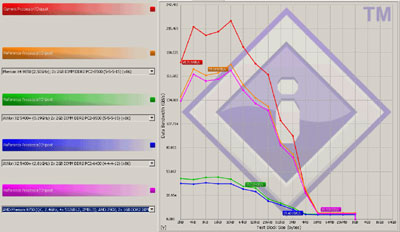
The documentation for this particular test is slightly murky, so I’ve come to the conclusion that the numerical result is based on the mean or average of the measurements from all the different data sizes used. At the 1MB mark the Phenom’s L3 cache helps it outperform the X2 by roughly 1000%!
Processor – Arithmetic:
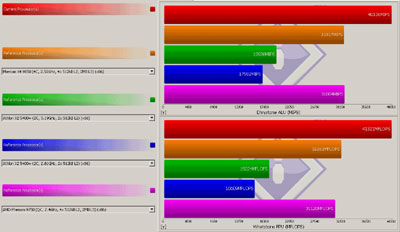
In the Dhrystone ALU (Arithmetic/Logic Unit) test we can see the overclocked Phenom X4 gaining 26% in performance from a 28% clock speed increase. With twice the cores of the Athlon X2 5400+, and the same 3.2GHz frequency, the Phenom manages to eke out 201% more performance. Linear scaling is always good to see.
In the Whetstone FPU (Floating Point Unit) test the Phenom X4 stretches its lead. With both processors at stock frequencies, the Phenom is just shy of doubling the performance of the X2 despite a 300MHz clock speed deficit, albeit with an extra two cores. When compared at overclocked speeds, the Phenom storms away from the Athlon, with a 215% victory. This can most likely be attributed to the inclusion of 128-bit wide floating point execution units in the new K10 architecture.
Processor – Multimedia:
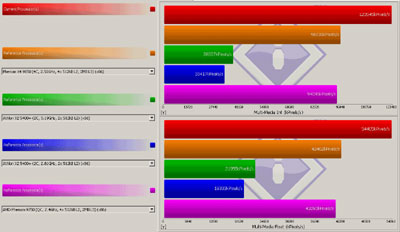
A famous saying comes to my mind, something to do with pictures and thousands of words. Bad jokes aside, in the integer test, at stock settings, the Phenom blows away the X2 with a 287% walloping. Overclocking to 3.2GHz apiece increases the margin in the Phenom's favour, ballooning out to a 325% advantage.
The Float test tells a similar story, as the Phenom begins with a 219% advantage that wiggles out to 247% when we crank up the frequency. In both of these multimedia tests the overclocked Phenom is actually performing fractionally more than its 28% frequency edge over the factory setting, which is fantastic.
Cryptography:
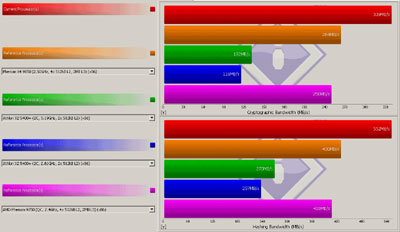
This benchmark follows the pattern set by the Multimedia test. At stock frequencies, the Phenom starts out with a 227% advantage, which kicks out to 256% at 3.2GHz. Again, the performance of the overclocked Phenom is fractionally quicker than its 28% clock speed head start.
Colin McRae DiRT:
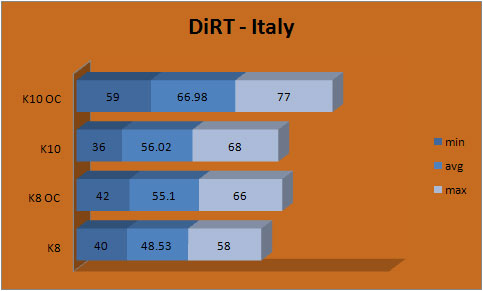

The 2.5GHz Phenom X4 looks roughly equivalent to the overclocked Athlon X2, and then streaks away when pushed to 3.2GHz, opening up about a 20% lead. The ATI Radeon 4870X2 really shines here, the in-game settings are completely maxed out with 4x anti-aliasing, and even on the $110 Athlon X2 it provides silky smooth gameplay. Check out the screenshot from the Japan stage.

Race Driver: GRID:

A familiar pattern by now; the Phenom stretches its lead over the Athlon X2 after the frequency is bumped up, this time going from a 23% advantage to 29%. This game is another example of the raw power of this monstrous ATI GPU. Again the settings were maxed, this time with 8x anti-aliasing, and the gaming experience was sublime, as this screenshot will indicate.

|
|
Advertisement:
All original content copyright James Rolfe.
All rights reserved. No reproduction allowed without written permission.
Interested in advertising on OCAU? Contact us for info.
|

|


